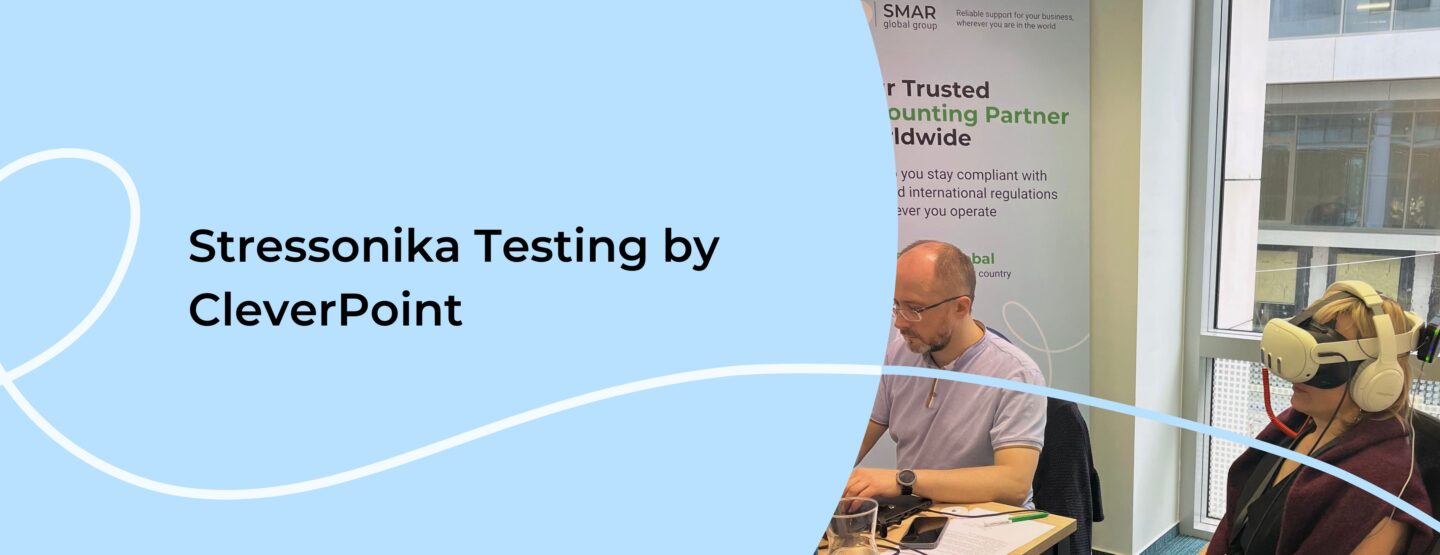Recently, our team underwent an unusual assessment “Stressonika”. We wanted to understand how each of us responds to stress, how effectively we perform under noise, fatigue, and multitasking conditions.
The testing was conducted by CleverPoint, a company specializing in VR devices and cognitive assessment technologies. This was a special moment for us since CleverPoint was one of our first clients in Poland and has now become our partner in team development.
How did it work?
The test lasted 25 minutes and included two main tasks, two short breaks, and several warm-up exercises, which were also assessed. The key challenge was not only completing the tasks but also managing the transition between activity and rest, restoring resources, and re-engaging in work efficiently.
During the test, the equipment monitored:
- How quickly we could relax after an intense task – could we recover rapidly, or did we remain in a state of stress?
- How we approached new tasks – did we adapt immediately, or did we need time to adjust?
- How our stress levels changed during the task – did tension build up, or did we maintain stability?
- How we performed towards the end – did we stay focused, or did we make mistakes at the final stage?
Additionally, the system analyzed the strategies we used to complete the tasks:
- How we processed visual information – did we utilize the entire screen space, or did we focus on specific areas?
- How our bodies reacted – pulse rate and physiological responses were recorded.
Essentially, the test was not just about assessing cognitive skills but also about understanding how our bodies handle work-related stress. These insights help us better grasp individual characteristics and find ways to enhance efficiency without overloading ourselves.
After the testing, we received a detailed breakdown of our results: how to interpret the data, what it reveals about our productivity, and how to apply these insights in our daily work.
What Did the Results Show?
- Attention span. Even if someone seems fully focused, the numbers may tell a different story. Some participants found their productivity dropped by half when working in a noisy environment.
- Nervous system and stress. One of the key insights was understanding why some people handle heavy workloads effortlessly while others need a different work format to avoid burnout.
- Reaction speed. The test assessed how quickly the brain processes information and transmits signals to the body. Some participants reacted instantly, while others needed more time.
Conclusion: These nuances should be considered when assigning tasks. If someone consistently loses focus on long tasks, they might be better suited for work that requires quick decision-making.
Why Does This Matter?
We always emphasize that a conscious approach to business is essential not only for clients but also for the team.
- Understanding one’s strengths and weaknesses helps people work more effectively without pushing themselves into overload.
- Workflows can be structured to match real human capabilities rather than just expectations.
- A team grows stronger when each member understands their strengths and how to collaborate with colleagues.
After the testing, we discussed how to apply these insights to our work—how to plan tasks based on individual needs, which techniques help manage stress, and how to maintain focus.
Another key takeaway: Offline meetings are essential
Our entire team works remotely, and in-person interactions happen less often than we’d like. That’s why these events are not just about testing—they’re about team building.
- When people meet in person, they understand each other better.
- We can not only analyze results but also discuss which solutions work best for our team.
- Casual conversations foster a sense that we’re not just working at the same company but creating something meaningful together.
We’ve confirmed that offline meetings should become a regular part of our work. Even if we can’t gather the entire team, key members should meet in person. It’s not just about discussing tasks—it’s about feeling the direction we’re heading in.
What’s next?
- We want to make these tests a recurring practice—they are a powerful tool that fosters both professional skills and self-awareness.
- We will introduce personalized techniques to improve focus, stress management, and productivity.
- We will schedule in-person meetings at least once per quarter because direct interaction strengthens the team.
This experience was incredibly valuable. We learned more about ourselves than we expected—and now we know exactly how to apply this knowledge in our work.
A huge thank you to our colleagues at CleverPoint for conducting these tests! They not only evaluated our results but also helped us interpret them correctly and provided practical solutions to enhance our efficiency. We’re excited to continue this collaboration—testing, analyzing, and developing team growth strategies together.

 Pl
Pl RU
RU


Powiązane posty: